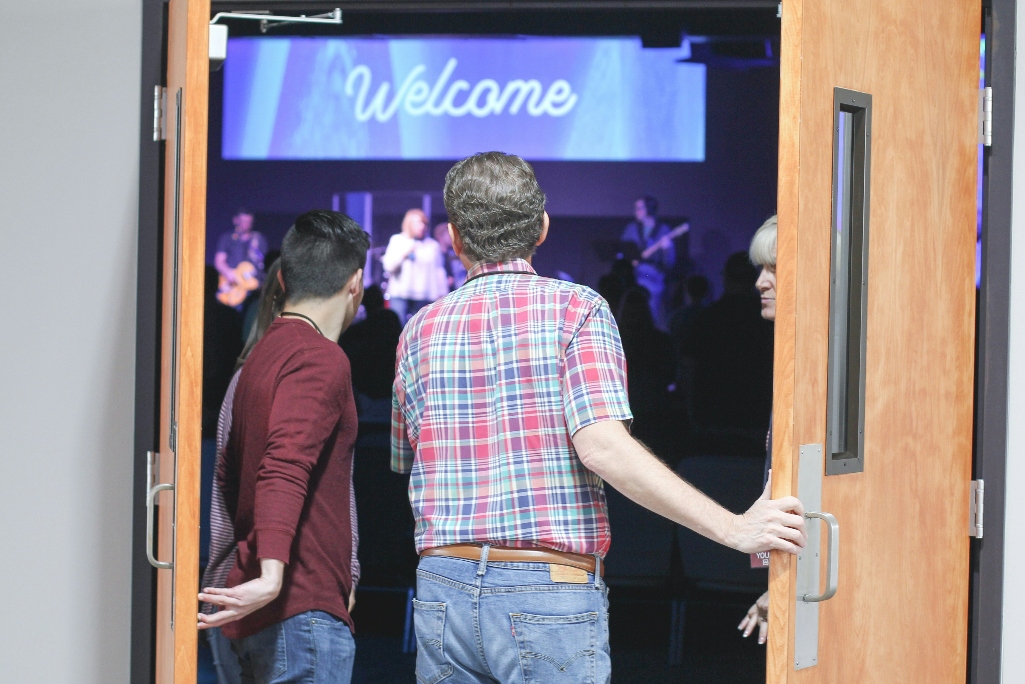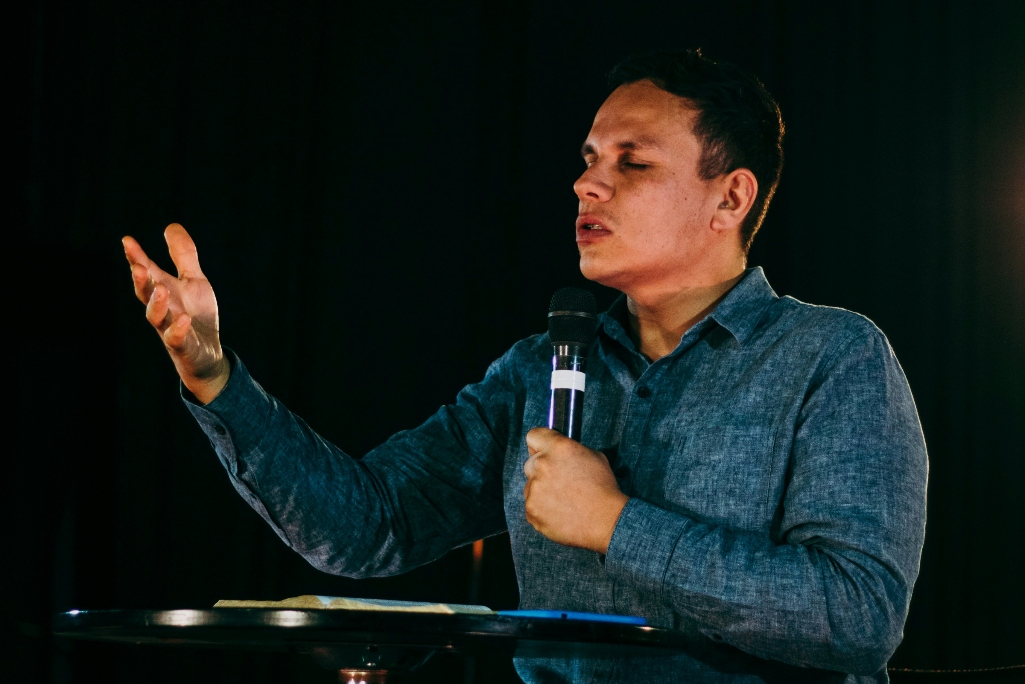
BRENTWOOD, Tenn. (BP) – Pastors of Hispanic Protestant churches in the United States maintain immense gratitude for their role, but many face financial struggles. Their congregations reflect diverse worship styles, but they have a unified desire to reach and serve their communities.
Lifeway Research partnered with numerous denominations and church networks to survey Hispanic Protestant pastors in the United States for a study sponsored by Lifeway Recursos, the Billy Graham Evangelistic Association and Samaritan’s Purse. This study follows a Lifeway Research study of U.S. Hispanic Protestant pastors last year that focused on the congregations and their evangelistic outreach.
“The response from pastors and leaders about the first study we did last year was overwhelming,” said Giancarlo Montemayor, director of global publishing for Lifeway Recursos. “The goal with this second study is to dig deeper into some of the nuances of the Hispanic church in the U.S., such as worship and outreach. We also wanted to pay close attention to the particular needs of the pastors serving in these communities who often struggle with cultural and political issues that are not present in an English-speaking church.”
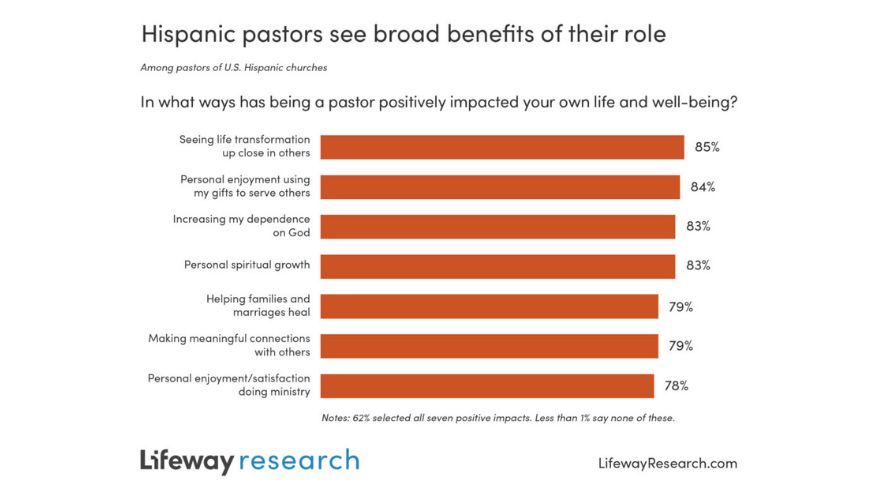
Pastoral perspectives
The average Hispanic Protestant pastor shares many similarities with other Protestant pastors while also having some unique characteristics. Participating pastors are overwhelmingly evangelical, with 82 percent identifying as such compared to 17 percent who say they are mainline Protestant.
Seven in 10 have some type of higher education, including 44 percent who have a graduate degree. In terms of their theological education, almost half have completed Bible institute training (47 percent) or seminary courses (46 percent). More than a third have a master’s degree from a seminary (38 percent) or have taken courses from a Bible college (34 percent). A quarter (25 percent) have completed church-based school courses, while 12 percent have a seminary doctoral degree. Few (3 percent) say they have no formal theological education.
Half of U.S. Hispanic Protestant pastors (51 percent) say they work full-time at their church. Three in 10 (30 percent) serve bivocationally, 13 percent volunteer, 6 percent are part-time and 1 percent are interim.
Of those who are bivocational, 88 percent work 20 or more hours at their outside job, including 51 percent who work at least 40 hours outside of the church. Those bivocational pastors say they do so primarily because it is a financial necessity for their families (79 percent). Half (48 percent) say they have a second job because it helps the church financially. Three in 10 (30 percent) work externally because their family needs the insurance benefits. Less than a quarter say they do so to better identify with the population they want to reach (23 percent) or because they feel called to be bivocational (21 percent). Almost 1 in 5 (18 percent) say they have a job outside of their church because they enjoy working.
Half (52 percent) of Hispanic Protestant pastors say their spouse also works to help the family financially, including 29 percent who say the extra income is essential and 23 percent who say it makes things easier financially for their family. Few (6 percent) say their spouse works but the income is not essential. Almost 2 in 5 (38 percent) say their spouse does not have a paid job that is needed to help sustain their family’s living expenses.
“The sources of training for pastors of Hispanic churches are more diverse than seminaries alone,” said Scott McConnell, executive director of Lifeway Research. “In the same way that some could not be full-time students to prepare for the pastorate, many must maintain employment in addition to their role as pastor to provide financially for their families.”
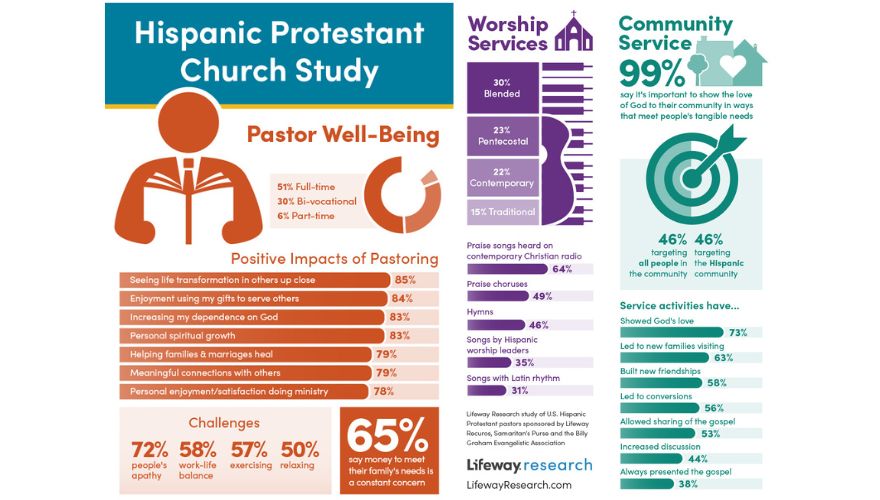
U.S. Hispanic Protestant pastors were also asked questions similar to Lifeway Research’s recent Greatest Needs of Pastors study to determine their most pressing issues. However, these questions and options arose from interviewing Hispanic Protestant pastors specifically.
Pastors were asked about challenges in their family’s life, emotional and physical wellbeing, congregational dynamics and personal needs. A majority identified four specific issues they said need attention – apathy or lack of commitment from people in their congregation (72 percent), balancing time between work and home (58 percent), consistently exercising (57 percent) and taking time to relax and have fun away from work (50 percent).
When dealing with issues, U.S. Hispanic Protestant pastors are most likely to regularly turn to their spouse. Half (51 percent) say they openly share their struggles with their spouse at least once a month. More than a third (37 percent) turn to another pastor. Around a quarter talk with a close friend (26 percent) or a mentor (24 percent). Fewer share monthly with another leader at church (13 percent), a counselor (7 percent) or a Bible study group in the church (6 percent). Almost 1 in 5 (18 percent) say they don’t openly share their struggles with any of these people in their life.
Regardless of any challenges, Hispanic Protestant pastors in the U.S. believe leading a church has benefited them in several ways. More than 4 in 5 say they’ve been positively impacted as a pastor through seeing life transformation in others up close (85 percent), experiencing personal enjoyment using their gifts to serve others (84 percent), increasing their dependence on God (83 percent) and seeing personal spiritual growth (83 percent). Slightly fewer said they’ve seen positive personal impact through helping families and marriages heal (79 percent), making meaningful connections with others (79 percent) and experiencing personal enjoyment or satisfaction doing ministry (78 percent). Less than 1 percent say they’ve had none of these, while 62 percent of pastors say they’ve experienced all seven.
“While many have come to realize the very real difficulties that pastors face in the U.S., pastors of Hispanic churches are quick to focus on the positives,” McConnell said. “Many of those in Hispanic churches work long hours and their pastors often do the same. Amidst these challenges, pastors have grown spiritually and enjoy serving others.”
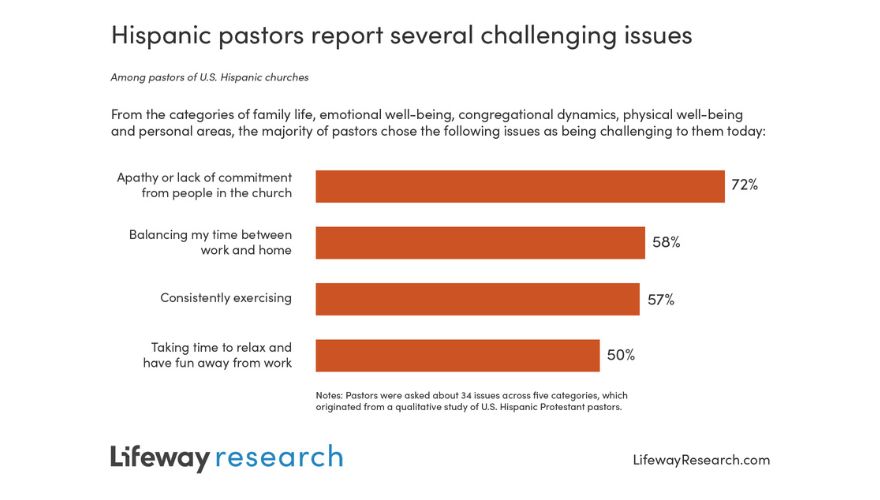
Worship service
As to the types of worship services U.S. Hispanic Protestant pastors lead, the potential variety stands out. They are most likely to say their style of service would be described as either blended traditional/contemporary (30 percent), Pentecostal (23 percent), contemporary (22 percent) or traditional (15 percent). Few see their worship services as liturgical (3 percent), post-modern/emerging (2 percent) or urban contemporary (2 percent).
During those services, attendees are most likely to hear praise songs heard on contemporary Christian radio (64 percent). Almost half of pastors say their church uses praises choruses (49 percent) or hymns (46 percent), while around a third feature songs written by Hispanic worship leaders (35 percent) or songs with a Latin rhythm (31 percent).
As part of the worship, churches are more likely to use words projected on the screen (90 percent) than hymnals (18 percent). Around half feature sermon notes on the screen (53 percent) or show a video (49 percent). The most popular instruments used are guitar (78 percent), piano or keyboard (77 percent) and drums (71 percent). Few use an organ (8 percent), while half say they use some other instrument (51 percent).
“Worship services in the Hispanic church within the U.S. are considerably challenging because you deal with first, second and third generations of immigrants who among themselves have specific needs,” said Montemayor. “A first-generation immigrant believer will probably need a service completely in Spanish, whereas the second- and third-generation may have lost some of the cultural and linguistic characteristics of their parents, preferring a sermon in English but songs in Spanish.”
Services in U.S. Hispanic Protestant churches feature many of the same elements as other Protestant churches and often repeat them each week. Almost every church has a sermon (99 percent), Scripture reading (96 percent) and congregational singing (95 percent) each week. Around 9 in 10 say their weekly service includes pastoral prayer (93 percent), attendees greeting one another (91 percent) and intercessory prayer for the sick and needy (87 percent). Around 7 in 10 also feature each week an invitation to respond or altar call (72 percent), congregational reading (70 percent) and children’s stories (69 percent).
Other elements are more sporadic or dependent on the specific congregation. Almost 2 in 5 (38 percent) say the congregation recites a prayer each week, but 45 percent say that never happens in their church. A time for testimonies occurs weekly in 38 percent of U.S. Hispanic Protestant churches, monthly in 25 percent, quarterly in 13 percent, less than once a quarter in 16 percent and never in 9 percent. For a handful of congregations, reciting creeds happens weekly (15 percent), monthly (4 percent), quarterly (5 percent) or less frequently (10 percent), but 2 in 3 pastors (66 percent) say it never happens in their church.
Almost all Hispanic Protestant churches in the United States regularly include partaking in the Lord’s Supper (99 percent) and baptizing someone (97 percent), but their rhythms for doing so vary. The most popular timing for the Lord’s Supper is monthly (58 percent), followed by quarterly (22 percent), weekly (12 percent) and less than once a quarter (7 percent). Baptisms are less frequent, with almost half saying they happen at their church less than quarterly (47 percent) and slightly fewer saying the time frame is usually quarterly (39 percent). Fewer say they have baptisms monthly (7 percent) or weekly (4 percent).
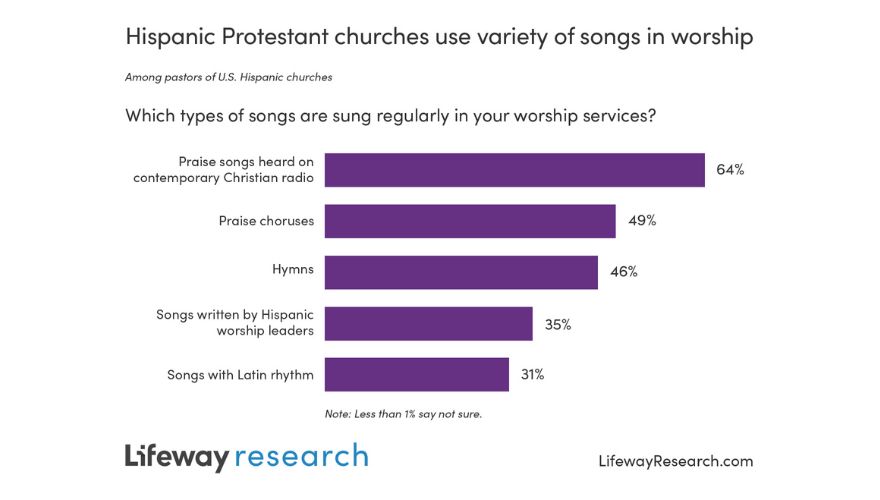
Community service
U.S. Hispanic Protestant churches aren’t only concerned with what happens inside their buildings. Serving their community is a priority. Almost every pastor (99 percent), including 88 percent who strongly agree, says it is important for their church to show the love of God to their community in ways that meet people’s tangible needs.
Pastors are split as to who they are most seeking to minister to with their service projects or ongoing service ministries: 46 percent say all people in their community, and 46 percent say all Hispanic people in their community. Few (6 percent) say they are specifically focusing on recent Hispanic immigrants.
“The Hispanic church in the U.S. is characterized by meeting tangible needs of those in their community through service,” McConnell said. “Some Hispanic churches seek to meet needs of everyone around them, while others focus on serving Hispanic people because of language or affinity.”
When asked specifically how they served the community in the past year, 92 percent said they were doing something. Most said they provided marriage counseling (60 percent) and fed the hungry (53 percent). Many provided clothing for the poor (44 percent), gave back-to-school materials for children (43 percent), helped people find employment (39 percent), helped the elderly (31 percent) and helped people find housing (29 percent). Fewer said their church supported local schools (21 percent), provided aid for mothers of newborns (17 percent), helped disaster victims (17 percent), met with people in prison (13 percent) or provided recovery or addiction ministries or groups (11 percent). Few churches sheltered the homeless (9 percent), tutored school kids (8 percent), offered after school programs (6 percent) or volunteered to provide foster care (3 percent).
In terms of ministering to immigrants, 89 percent of U.S. Hispanic Protestant pastors said their church is equipped to serve new immigrants in their community. Specifically, 75 percent identified a way they served immigrants in the last year. More than half (54 percent) said they met information needs. Around 2 in 5 provided rides or transportation (41 percent) and supplied assistance with legal and immigration issues (37 percent). A quarter (24 percent) said they taught money management, while 18 percent offered English as a second language classes or mentors and 9 percent taught job skills.
While 70 percent of pastors agree they always have the resources they need to support the ministries they consider essential, they also indicate they could probably do more if they had more. Most said significant challenges to serving their community include the need to train more people (56 percent), a lack of financial resources (52 percent) and not enough workers to go out and serve (51 percent). Slightly less than half point to the lack of resources to offer any immigration legal help (49 percent), not having the leaders to take responsibility (47 percent) and difficulty devoting the required time (44 percent). Fewer say they do not have the facilities (31 percent), many people within the church are among those who need help (30 percent) and they lack knowledge of employment and housing opportunities (23 percent).
Nine in 10 U.S. Hispanic Protestant pastors (86 percent) say their church’s teaching, evangelism and discipleship efforts have been impacted by their community service. Around 3 in 4 say their church has been able to show God’s love to their community (73 percent). Most say their service has led to new families visiting their church (63 percent), new friendships built with people in the community (58 percent) and individuals accepting Christ as their Savior (56 percent). Many (44 percent) say the church’s service in the community has increased people’s openness to discuss and listen to what the church has to say. Most pastors (53 percent) say their community work has given them opportunities to share the gospel message occasionally, while 38 percent say their service projects always included a presentation of the gospel.
“My prayer is that the global church could use this study to better inform their decisions on how to reach the Hispanic community and help churches already doing the heavy work,” said Montemayor.
For more information, view the frequencies report, the differences report or visit LifewayResearch.com.
To access the reports in Spanish, visit LifewayRecursos.com.
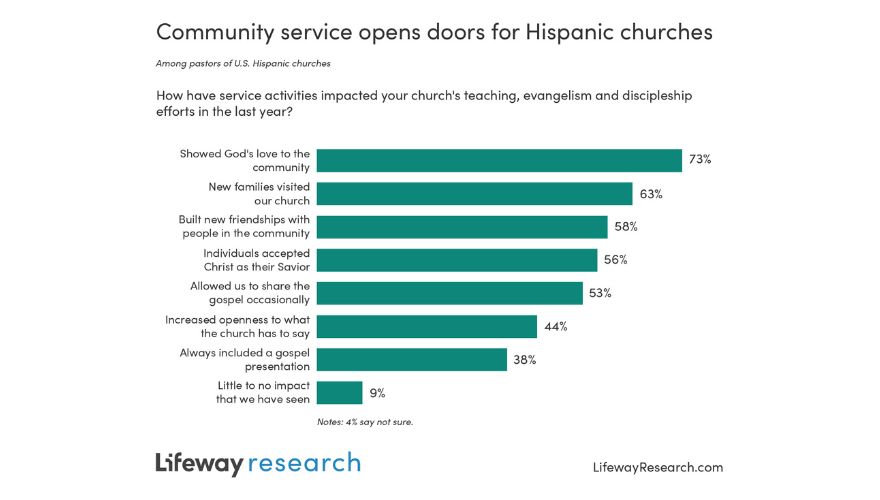
Methodology
The online survey of 554 pastors of Hispanic Congregations in the U.S. was conducted Sept. 12 – Nov. 1, 2023. It was sponsored by Billy Graham Evangelistic Association, Samaritan’s Purse and Lifeway Recursos.
Respondents were invited by individual denominations and networks, including Assemblies of God, Baptist Missionary Association of America, Christian Church (Disciples of Christ), Christian Reformed Church North America, Church of God (Cleveland), Church of the Nazarene, Christian & Missionary Alliance, Converge, Episcopal Church, Evangelical Free Church of America, Foursquare, Free Methodists, New Thing, North American Baptists Conference (Hispanics for Christ), Presbyterian Church in America (MNA), Reformed Church in America, Southern Baptist Convention, United Pentecostal Church International, Vineyard and Wisconsin Evangelical Lutheran Synod, as well as churches connected to the Billy Graham Evangelistic Association, National Hispanic Christian Leadership Coalition (NHCLC) and National Latino Evangelical Coalition (NaLEC).
Invitations were primarily made by email, providing pastors with a link to the online survey. Each respondent was screened to ensure they were the senior pastor or the pastor of the Hispanic campus or Spanish-speaking congregation.
Respondents were screened to ensure the congregation was a Hispanic or multiethnic church or a Spanish-speaking worship service or campus within a non-Hispanic church (Pastors of a campus or Spanish-speaking worship service were instructed to only answer for that campus/service). Only congregations that are at least 50 percent Hispanic were included.
Slight weights were used to adjust for varying response rates across denominations. The completed sample is 554 surveys. The sample provides 95 percent confidence that the sampling error does not exceed plus or minus 5.2 percent. This margin of error accounts for the effect of weighting. Margins of error are higher in sub-groups.
(EDITOR’S NOTE – Aaron Earls is a writer for LifeWay Christian Resources.)

